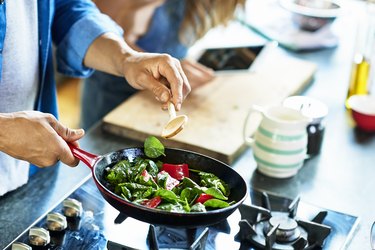
When you check a food's nutrition facts, the label may not tell the full story. Depending on how it's prepared, nutrients may be lost or become more available.
Cooked vegetables are typically more enjoyable than eating them raw, but boiling or sautéeing them can change their nutritional profiles. The important part: Choosing the right cooking method may help preserve more nutrients in your vegetables.
Video of the Day
Video of the Day
So how do you choose the right method? This depends on the nutrients in the vegetables, and whether they're water- or fat-soluble. Here are the most nutritious ways to cook vegetables, according to registered dietitians.
1. Steaming
Steaming is one of the best ways to cook vegetables if preserving the maximum amount of nutrients is your goal. It's considered the best cooking method to preserve the vitamin C in vegetables, according to a September 2013 study in Nutrition & Food Science.
"Steaming is a preferred way to prepare vegetables for taste, appearance and even nutrition," says registered dietitian Jamie Lee McIntyre, RDN. "Cooking vegetables in water, such as boiling, can cause water-soluble vitamins like vitamin C to be leached out. With steaming, the nutrients are retailed to a larger degree since food doesn't come into direct contact with the water like with boiling."
McIntyre says that some of the nutrients may be released with steam, but it's a small percentage and doesn't negate the benefits of eating steamed vegetables.
Tip
If you’re worried about the small amount of nutrients lost during steaming, McIntyre recommends conserving the liquid and adding back to the meal in the form of a sauce or broth.
2. Sautéeing
Sautéeing and stir-frying result in very flavorful veggies. Stir-frying tends to use high heat, but sautéeing on a low heat will preserve more nutrients that would otherwise be lost when heated.
"Cooking veggies gently on a lower heat setting is key to reducing the likelihood of denaturing some of the water-soluble vitamins," explains registered dietitian Jenna Volpe, RDN, LD.
Adding a little bit of cooking oil to the pan will prevent the vegetables from sticking but may also increase the bioavailability of some nutrients. Adding vegetable oil to vegetables may make carotenoids (precursors to vitamin A) and some fat-soluble vitamins more available, according to August 2017 research in The American Journal of Clinical Nutrition.
Because water isn't involved in this cooking method, water-soluble nutrients are likely to stay intact.
3. Microwaving
Contrary to popular belief, using a microwave is a convenient and nutritious way to cook foods.
Still, microwaving results in minor decreases in vitamin C levels, according to a May 2020 study in Foods. That isn't the microwave's fault, though: Vitamin C breaks down when heated, and microwaves provide a source of heat.
But microwaving doesn't destroy as many nutrients because it cooks food relatively fast, and the shorter cook times help preserve nutrients, according to Harvard Health Publishing.
"Microwaving is a good method for retaining nutrients because of the short cooking time," says Tia Glover, RD. If you're in a pinch, microwaving your vegetables is fast and nutritious.
4. Roasting
If you don't want to cook with water or oil, try a dry-heat method like roasting for your vegetables. It doesn't leach water-soluble vitamins, but all forms of heat reduce some nutrients so you'll want to avoid overcooking.
"Roasting is a great way to retain B vitamins and vitamin C," says Christianna Gozzi, RD. "It doesn't require liquid, so there's no significant water-induced loss."
Similarly, you can bake your vegetables — think: sweet potatoes, carrots, onions and bell peppers. "Adding shredded carrots or zucchini to baked goods or making vegetable tarts are great examples of baking vegetables," Gozzi adds.
5. Boiling
Boiling — it's simple, fat-free and fast. But it tends to rank on the lower end of cooking methods for nutrient retention.
"Boiling seems to be among the worst methods for retention of nutrients, especially for those water-soluble vitamins," Glover says. "That being said, consuming the water it was cooked in, such as with soups, can help."
Compared to other cooking methods like microwaving, boiling results in the greatest loss of vitamin C, according to an April 2018 study in Food Science and Biotechnology. The nutrients lost are generally leached into the cooking water.
"Water-soluble vitamins, such as B vitamins and vitamin C, are most often lost in water-based cooking methods such as boiling since they dissolve in the water," Volpe says. But fat-soluble vitamins like vitamins A and K are mostly unaffected by cooking, so boiling your vegetables is still worth it to get the other nutrients.
In some cases, boiling can increase nutrient availability. Vitamin A, iron and calcium may be more available in boiled spinach, for example, according to the University of Florida.
Related Reading
The Bottom Line
No matter the cooking method, eating your vegetables is better than not eating greens at all.
When you cook your vegetables, some nutrients are inevitably lost, but the cooking process may also increase the availability of other nutrients.
When in doubt, steam, sauté or microwave your veggies. But eating vegetables — in nearly any form — is what's most important.
- Nutrition & Food Science: “Effects of different cooking methods on the vitamin C content of selected vegetables”
- The American Journal of Clinical Nutrition: “Modeling the dose effects of soybean oil in salad dressing on carotenoid and fat-soluble vitamin bioavailability in salad vegetables”
- Harvard Health Publishing: “Microwave cooking and nutrition”
- Foods: “Influence of Cooking Conditions on Nutritional Properties and Sensory Characteristics Interpreted by E-Senses: Case-Study on Selected Vegetables”
- Food Science and Biotechnology: “Effect of different cooking methods on the content of vitamins and true retention in selected vegetables”
- University of Florida: “Eating Defensively: The Nutrition and Food Safety Benefits of Cooked Produce”


